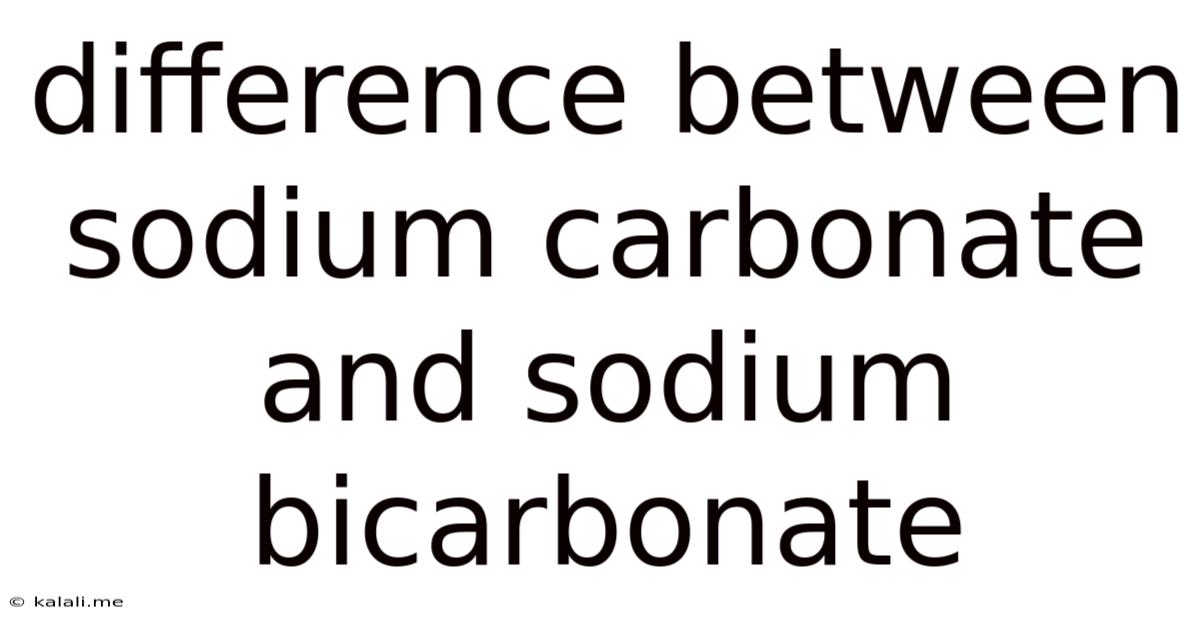Difference Between Sodium Carbonate And Sodium Bicarbonate
Kalali
Jun 11, 2025 · 3 min read

Table of Contents
Sodium Carbonate vs. Sodium Bicarbonate: Understanding the Key Differences
Sodium carbonate and sodium bicarbonate are both sodium salts of carbonic acid, often found in our homes and used in various applications. While they share similarities, understanding their key differences is crucial for choosing the right compound for specific tasks. This article will delve into the chemical properties, common uses, and safety considerations of both substances.
What is Sodium Carbonate (Washing Soda)?
Sodium carbonate, also known as washing soda or soda ash, is a chemical compound with the formula Na₂CO₃. It's a strong alkali, meaning it readily accepts protons (H⁺) in a solution, resulting in a higher pH. This high pH makes it effective in cleaning and other applications requiring alkalinity. It's typically available as a white, odorless powder.
What is Sodium Bicarbonate (Baking Soda)?
Sodium bicarbonate, commonly known as baking soda, has the chemical formula NaHCO₃. Unlike sodium carbonate, it's a weak base. It reacts with acids to produce carbon dioxide gas, a property that makes it crucial in baking as a leavening agent. It also finds use in cleaning, deodorizing, and as an antacid. It appears as a fine, white powder.
Key Differences between Sodium Carbonate and Sodium Bicarbonate:
Here's a table summarizing the key differences:
| Feature | Sodium Carbonate (Na₂CO₃) | Sodium Bicarbonate (NaHCO₃) |
|---|---|---|
| Chemical Name | Sodium Carbonate, Washing Soda, Soda Ash | Sodium Bicarbonate, Baking Soda |
| Chemical Formula | Na₂CO₃ | NaHCO₃ |
| pH | Highly alkaline (pH > 11) | Mildly alkaline (pH ~8) |
| Strength | Strong base | Weak base |
| Reactivity with Acids | Reacts vigorously | Reacts moderately, releases CO₂ |
| Uses | Cleaning, water softening, glass manufacturing | Baking, cleaning, deodorizing, antacid |
Understanding their Uses:
-
Sodium Carbonate (Washing Soda): Its high alkalinity makes it a powerful cleaning agent. It's effective at removing grease, grime, and stains from clothes and surfaces. It's also used in water softening to remove hardness minerals, and in various industrial processes such as glass manufacturing and paper production.
-
Sodium Bicarbonate (Baking Soda): Its mild alkalinity and reaction with acids make it versatile. In baking, the reaction with acids in other ingredients (like vinegar or buttermilk) produces carbon dioxide, making baked goods rise. It's also a mild abrasive cleaner, effective at removing odors, and acts as an antacid to neutralize stomach acid.
Safety Considerations:
Both sodium carbonate and sodium bicarbonate are generally considered safe when used appropriately. However, direct contact with concentrated solutions can irritate skin and eyes. Always wear appropriate protective gear when handling large quantities or concentrated solutions. Ingestion of large amounts can also cause adverse health effects. Always refer to the product label for specific safety instructions.
Conclusion:
While both sodium carbonate and sodium bicarbonate are useful compounds, their different chemical properties lead to distinct applications. Understanding these differences allows for the proper selection of the compound needed for a specific task, ensuring optimal results while maintaining safety. Whether you're cleaning your kitchen, baking a cake, or tackling a more industrial application, choosing the right sodium compound is key.
Latest Posts
Latest Posts
-
How Many Ounces In Pound Of Meat
Jul 02, 2025
-
What Is The Diameter Of A Quarter
Jul 02, 2025
-
Spoon Gets Hot In A Bowl Of Soup
Jul 02, 2025
-
How Many Cups In A 16 Oz Sour Cream
Jul 02, 2025
-
How Many 1 4 Teaspoons Are In 1 Teaspoon
Jul 02, 2025
Related Post
Thank you for visiting our website which covers about Difference Between Sodium Carbonate And Sodium Bicarbonate . We hope the information provided has been useful to you. Feel free to contact us if you have any questions or need further assistance. See you next time and don't miss to bookmark.